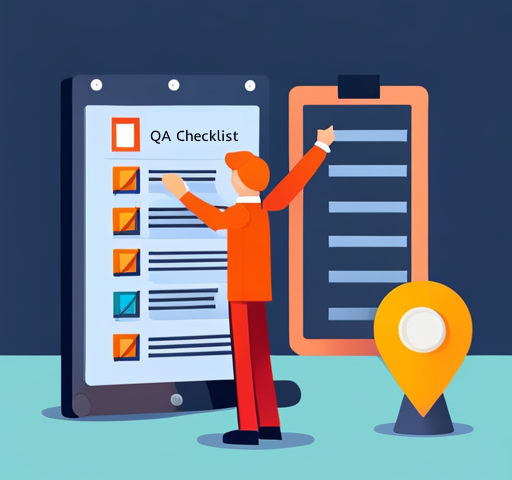
How to add Slack Bot to a channel
June 27, 2023
The Role of Visual Bug Tracking in Streamlining Web Development: How Visual Debug Can Help
September 12, 2024In today's digital age, your website serves as the initial interaction with potential customers. As a result, it's vital to prioritize its quality and performance. One of the most effective methods for achieving this is by utilizing a comprehensive Website QA Checklist. In this article, we will provide a detailed breakdown of the essential components of a proper QA checklist, along with examples and guidance on ensuring the quality of your website.
In today's digital age, your website serves as the initial interaction with potential customers. As a result, it's vital to prioritize its quality and performance. One of the most effective methods for achieving this is by utilizing a comprehensive Website QA Checklist. In this article, we will provide a detailed breakdown of the essential components of a proper QA checklist, along with examples and guidance on ensuring the quality of your website.
What is a Website QA Checklist?
A Website QA Checklist is a simple yet powerful tool that helps ensure your website is in top-notch condition and delivers a positive user experience. It serves as a comprehensive guide, covering all the essential aspects that need to be examined and tested. By following a Website QA Checklist, you can systematically evaluate and address various elements of your website, guaranteeing its functionality, usability, performance, compatibility, content quality, and SEO optimization.
The Comprehensive Website QA Checklist
1. Functionality
Functionality is a crucial aspect of a website. It ensures that all the interactive elements and features are working correctly, providing a smooth user experience. Here are some real-world examples of what to check for in terms of functionality:
- Links: Verify that all internal and external links on your website are functioning properly. Click on each link to ensure they lead to the intended destination without any errors or broken links.
- Forms: Test all forms on your website to ensure they are submitting data correctly. Check for proper validation of form fields, error messages for invalid submissions, and successful submission confirmation.
- Search Functions: If your website has a search feature, test it thoroughly. Enter different search queries and verify that the search results are accurate and relevant.
- Filters and Sorting Options: If your website allows users to filter or sort content, test these features. Apply different filters, sorting options, and combinations to ensure they work as intended and provide the expected results.
- Buttons, Checkboxes, and Drop downs: Interact with various buttons, checkboxes, and dropdown menus on your website. Ensure they respond correctly to user input, trigger the intended actions, and maintain their selected state when necessary
2. Usability
The usability focuses on creating a user-friendly and intuitive experience for visitors. Here are some real-world examples of what to consider when evaluating the usability of your website:
- Navigation: Review the navigation menu and ensure it is easy to locate and use. The menu should be consistent across all pages, providing clear and logical pathways for users to navigate through your website. Verify that important pages are easily accessible and labeled appropriately.
- Consistency: Ensure consistency in design elements and layout throughout your website. Consistent fonts, colors, and visual elements create a cohesive and professional look. This consistency helps users understand the structure of your website and find information more easily.
- Accessibility: Pay attention to accessibility guidelines, such as those outlined in the Web Content Accessibility Guidelines (WCAG). Ensure that your website is accessible to users with disabilities, including those who rely on assistive technologies. This may involve providing alternative text for images, using proper heading structures, and making forms accessible.
- Mobile Responsiveness: Test your website's responsiveness across various devices, including smartphones and tablets. Your website should adapt seamlessly to different screen sizes, maintaining usability and readability. Verify that all interactive elements, such as buttons and forms, are easily usable on mobile devices.
- Readability: Assess the readability of your website's content. Ensure that the font size and style are legible, and the text is well-organized with proper headings, paragraphs, and spacing. Consider the use of bullet points, numbered lists, and subheadings to enhance readability.
- Forms and Input Fields: Evaluate the usability of your website's forms and input fields. Make sure they are easy to fill out, with clear labels and appropriate placeholders. Validate form entries in real-time and provide helpful error messages for any incorrect submissions.
3. Performance
Performance plays a vital role in user satisfaction and engagement on a website. Here are some real-world examples of what to consider when evaluating the performance of your website:
- Page Load Speed: Test the load speed of your web pages using tools like Google PageSpeed Insights or GTmetrix. Aim for fast loading times, ideally under three seconds. Optimize your website by compressing images, minifying CSS and JavaScript files, and leveraging browser caching.
- Mobile Optimization: Verify that your website performs well on mobile devices. With the increasing use of smartphones and tablets, it is crucial to optimize your website for smaller screens. Test your website's mobile responsiveness and ensure quick loading times on mobile devices.
- Image and Media Optimization: Optimize all images, videos, and other media files on your website. Compress images without sacrificing quality using tools like ImageOptim or Squoosh. Consider using lazy loading techniques to load media files only when they become visible to the user.
- Caching: Implement caching mechanisms on your website to reduce server load and improve response times. Use browser caching to store static resources, such as CSS and JavaScript files, so that they don't need to be reloaded on subsequent visits.
- Scalability and High Traffic Handling: Test your website's performance under high traffic conditions. Use load testing tools like Apache JMeter or LoadRunner to simulate a large number of concurrent users. Monitor server response times and ensure your website remains accessible and responsive even during peak traffic periods.
- Content Delivery Network (CDN): Consider using a CDN to distribute your website's static files across multiple servers worldwide. This improves load times for visitors in different geographic locations by serving content from the nearest server.
4. Compatibility
Ensuring that your website is compatible with different browsers and devices is essential for reaching a wide audience. Here are some real-world examples of what to consider when evaluating the compatibility of your website:
- Cross-Browser Compatibility: Test your website on popular browsers such as Chrome, Firefox, Safari, and Edge. Check that your website displays correctly, and all functionalities work as intended on each browser. Pay attention to differences in rendering, CSS support, and JavaScript compatibility.
- Responsive Design: Verify that your website is responsive and adapts seamlessly to different screen sizes and resolutions. Test it on various devices, including desktops, laptops, smartphones, and tablets. Ensure that the content, images, and interactive elements are displayed properly and that the user experience remains consistent across different devices.
- Mobile-Friendly Design: With the increasing use of mobile devices, it's crucial to have a mobile-friendly design. Check that the website's layout, font sizes, and touch targets are optimized for mobile users. Ensure that menus and navigation are easily accessible and that users can interact with the website without any issues on their smartphones or tablets.
- Device Compatibility: Test your website on a range of devices and operating systems to ensure compatibility. Consider different screen sizes, resolutions, and device-specific features. This includes testing on iOS and Android devices, as well as various screen orientations (portrait and landscape).
- Browser Feature Support: Be mindful of browser-specific features or APIs that your website may rely on. Check for compatibility and provide fallbacks or alternative solutions for browsers that don't support certain features.
- CSS and JavaScript Compatibility: Ensure that your website's CSS styles and JavaScript code are compatible across different browsers. Test for any browser-specific issues, such as CSS rendering discrepancies or JavaScript errors, and address them accordingly
5. Content
High-quality and accurate content is vital for engaging users and conveying your message effectively. Here are some real-world examples of what to consider when evaluating the content on your website:
- Spelling and Grammar: Review all text content on your website, including headings, paragraphs, and captions. Ensure that there are no spelling or grammar errors. Use spell check tools or consider hiring a professional editor to ensure the content is error-free.
- Consistency in Tone and Style: Maintain consistency in the tone and style of your content throughout the website. Whether it's formal or casual, make sure the tone aligns with your brand voice and target audience. Consistency creates a cohesive user experience and reinforces your brand image.
- Alignment of Images and Videos: Check the alignment of images and videos within your website's layout. Ensure they are properly aligned, centered, and appropriately sized. Consistent alignment enhances the visual appeal of your content and improves readability.
- Image and Video Quality: Optimize the quality of images and videos on your website. Use high-resolution images that are clear and visually appealing. Compress images to reduce file size without compromising quality. Ensure that videos are properly encoded and play smoothly without buffering issues.
- Accuracy and Relevance: Regularly review your website's content to ensure it remains accurate and up-to-date. Update information, statistics, and any time-sensitive content as needed. Remove outdated or irrelevant content that may confuse or mislead users.
- Readable Formatting: Organize your content with proper formatting to enhance readability. Use subheadings, bullet points, and numbered lists to break up text and make it easier to scan. Ensure proper spacing between paragraphs and use a legible font size and type.
- Call-to-Action (CTA): Evaluate the effectiveness of your CTAs. Ensure they are clear, compelling, and strategically placed to encourage user engagement and conversions. CTAs should guide users towards desired actions, such as signing up for a newsletter or making a purchase.
6. SEO
Implementing SEO (Search Engine Optimization) best practices is essential for improving the visibility and search engine rankings of your website. Here are some real-world examples of what to consider when evaluating the SEO aspects of your website:
- Meta Tags: Ensure that all pages of your website have appropriate meta tags, including meta titles and meta descriptions. Meta titles should be concise, descriptive, and contain relevant keywords. Meta descriptions should accurately summarize the content of each page and entice users to click through in search results.
- Heading Structure: Use the correct heading structure (H1, H2, H3, etc.) to organize your content hierarchically. The H1 tag should be reserved for the main page title, and subsequent headings should follow a logical hierarchy. This helps search engines understand the structure and relevance of your content.
- Alt Tags for Images: Include descriptive alt tags for all images on your website. Alt tags provide alternative text that describes the image's content, allowing search engines to understand and index the image properly. Additionally, alt tags improve accessibility for visually impaired users who rely on screen readers.
- URL Structure: Create clean and user-friendly URLs that reflect the content of each page. Use descriptive keywords and hyphens to separate words in the URL. A well-structured URL not only helps search engines understand your content but also improves the user experience.
- Sitemap: Generate and submit an XML sitemap to search engines. A sitemap provides a list of all the pages on your website, helping search engines crawl and index your content more efficiently. Ensure that your sitemap is regularly updated and accurately reflects the current structure of your website.
- Robots.txt File: Create a robots.txt file to instruct search engine crawlers on which pages to crawl and index and which pages to exclude. Use the robots.txt file to control access to sensitive or duplicate content, and ensure that it is properly configured to align with your SEO goals.
- Keyword Optimization: Conduct keyword research and optimize your website's content by incorporating relevant keywords naturally. Use keywords in page titles, headings, meta tags, image alt tags, and throughout the content. However, ensure that keyword usage remains natural and does not compromise the readability or user experience.
- Page Speed: Optimize your website's loading speed, as it is a ranking factor for search engines. Compress images, minify CSS and JavaScript files, leverage browser caching, and utilize content delivery networks (CDNs) to improve page load times.
How Visual Debug Enhances Website QA
Visual Debug is a powerful tool that greatly enhances the Website QA process. Here's how Visual Debug can be of great help when using the QA checklist to evaluate a website:
- Efficient Feedback Collection: Visual Debug allows you to provide precise feedback by selecting specific elements on the website and leaving comments directly on them. This streamlines the feedback collection process and ensures that developers can quickly identify and address specific issues.
- Clear Communication: With Visual Debug, you can provide visual feedback directly on the website, making it easier to communicate observations and suggestions. You can highlight areas that require attention, draw annotations, and leave comments to provide clear instructions and explanations.
- Bug Reporting and Labeling: Visual Debug enables you to label feedback as bugs, categorizing and prioritizing issues effectively. This helps the development team identify critical issues that require immediate attention.
- Efficient Collaboration: Visual Debug facilitates efficient collaboration between QA testers and developers. Instead of relying on lengthy written explanations, testers can visually communicate their findings, and developers can refer to the annotations and comments when addressing reported issues. This streamlines the collaboration process and saves time.
- Seamless Integration with Task Management Tools: Visual Debug integrates with popular task management tools, allowing you to convert feedback into actionable tasks within your existing workflow. This ensures that identified issues are tracked and resolved efficiently.
By incorporating Visual Debug into your Website QA checklist, you can streamline the feedback collection process, improve communication, foster collaboration, and enhance the overall efficiency of the QA process. The precise feedback, bug labeling, and integration with task management tools empower your team to identify and resolve issues effectively, resulting in a high-quality and optimized website.
Conclusion
A comprehensive Website QA Checklist is an essential tool for ensuring your website delivers the best possible user experience. By covering all the bases, from functionality to SEO, you can ensure your website is performing at its best and driving your business forward.





